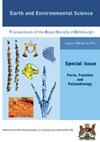Silicification of feathers in a modern hot spring in New Zealand
IF 1.2
4区 地球科学
Q4 GEOSCIENCES, MULTIDISCIPLINARY
Earth and Environmental Science Transactions of the Royal Society of Edinburgh
Pub Date : 2022-04-22
DOI:10.1017/S1755691022000068
引用次数: 0
Abstract
ABSTRACT Fossil feathers have greatly improved our understanding of the evolutionary transition from non-avian dinosaurs to birds and the evolution of feathers, and may be the only evidence for their source animals in the fossil record. Hot spring environments have been demonstrated to be conducive to the preservation of fossils, but internal silicification of feathers was not observed in the only avian carcass so far discovered in ancient hot spring deposits. To determine whether feathers can be internally silicified, here we analyse feathers sampled from a modern hot spring vent pool – Champagne Pool – in New Zealand. Our results of scanning electron microscopy (SEM)-energy dispersive X-ray spectrometry elemental mapping show that the sampled feathers are silicified to different degrees, and one of them is pervasively silicified. SEM observations show that feathers can be silicified at the cellular level. Degradation is involved in the silicification of feathers, as indicated by the reduction of the abundance of carbon and the loss of keratin fibrils. Our findings suggest that ancient deposits of hot spring vent pools are promising targets in search for fossil feathers.新西兰现代温泉中的羽毛硅化
羽毛化石极大地提高了我们对非鸟类恐龙向鸟类进化过渡以及羽毛进化的认识,可能是化石记录中唯一的羽毛来源动物的证据。研究表明,温泉环境有利于化石的保存,但迄今为止在古温泉沉积物中发现的唯一一具鸟类尸体中未观察到羽毛的内部硅化。为了确定羽毛是否可以内部硅化,我们分析了从新西兰一个现代温泉喷口池——香槟池——取样的羽毛。扫描电镜(SEM)-能量色散x射线能谱元素图分析结果表明,样品羽毛具有不同程度的硅化,其中一种为普遍硅化。扫描电镜观察表明,羽毛可以在细胞水平上硅化。降解与羽毛的硅化有关,如碳丰度的减少和角蛋白原纤维的损失所表明的那样。我们的发现表明,温泉喷口池的古代沉积物是寻找羽毛化石的有希望的目标。
本文章由计算机程序翻译,如有差异,请以英文原文为准。
求助全文
约1分钟内获得全文
求助全文
来源期刊
CiteScore
2.00
自引率
0.00%
发文量
21
期刊介绍:
Earth and Environmental Science Transactions (formerly Transactions of the Royal Society of Edinburgh: Earth Sciences) is a general earth sciences journal publishing a comprehensive selection of substantial peer-reviewed research papers, reviews and short communications of international standard across the broad spectrum of the Earth and its surface environments. The journal prides itself on the quality of its graphics and photographic reproduction. The Editors are keen to encourage interdisciplinary papers and Transactions also publishes occasional special symposia and invited volumes of specific interest.
We are currently in the process of digitising the archive of RSE Publications, and the archive of the Transactions, dating back to 1788, will be available from the back issues link on this site.

 求助内容:
求助内容: 应助结果提醒方式:
应助结果提醒方式:


